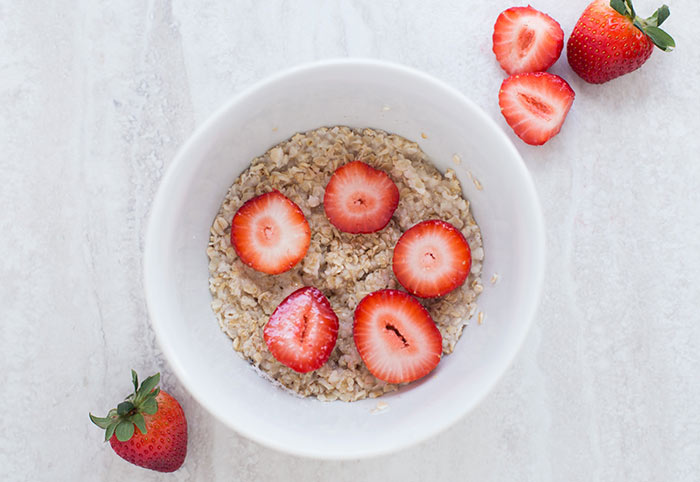
How to eat enough fiber on the low FODMAP diet
Today, I have a guest blog for you, written by the Dutch gut dietitian Manon from the blog Positive Gut. She shares a lot of interesting tips about getting more fiber into your diet. I hope you’ll find it interesting!
As you might have noticed, the FODMAP diet is a pretty restrictive diet. One of the nutrients that can become depleted is fiber. Fiber is a source of nutrition for your gut bacteria, it helps keep them healthy.
Your gut bacteria are the base of your immune system and create nutrients for you like vitamin K and Short Chain Fatty Acids (SCFA) to keep your intestinal lining healthy. All the more reason to keep those bacteria healthy and happy!
Studies have shown, that following the FODMAP diet for a longer period of time results in a loss of abundance in gut bacteria and also negatively alters the diversity of those bacteria, mostly by reducing bifidobacteria. Bifidobacteria are linked to immunological and metabolic health and healthy aging(*).
Since fiber is the main source of nutrition for these bacteria, it is important to prevent the reduction of bifidobacteria with the consumption of plenty of fiber.
So here’s the scoop on how to get enough fiber while following the FODMAP diet!
What is fiber?
Fiber is a carbohydrate that is present in a lot of foods. Your body is unable to break down fiber and as a result, your gut bacteria in your large intestine will partly break the fiber down and produce multiple types of nutrients for you, as mentioned above.
The part that doesn’t get broken down, will be a part of your stools.
A fun side effect of fiber is that it helps fill you up, and thus prevents you from getting hungry again quickly. It promotes healthy bowel movement because it adds bulk to the stools and binds moisture to it.
Fiber is present in foods like whole grains, fruits, vegetables, nuts and seeds. Unfortunately, a lot of these foods are also high in FODMAPs. Making it harder to reach your daily recommended intake (RDI) of at least 30 grams of fiber.
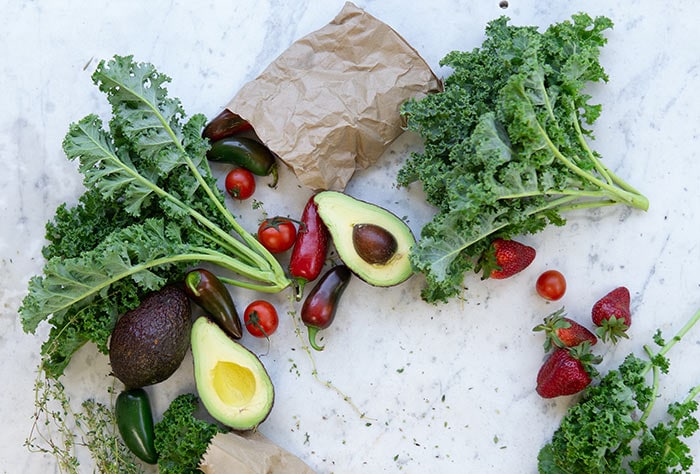
How to get enough fiber on the FODMAP diet?
Getting enough fiber on the FODMAP diet, comes down to making smart and fiber rich food choices.
To reach the 30 grams of fiber, try to aim for at least a daily intake of the following products:
200 – 300 grams of fruit
Really try to work this in to your daily routine. A serving of fruit of 100 grams contains on average 1,7 grams of fiber.
The total amount of fiber will vary between fruit types, but variety is key here for a balanced food pattern. 200-300 grams of fruit a day will get you up to 3.4 – 5.2 grams of fiber!
Of course it is important to pick the low FODMAP options. And with fruit there often is a maximum portion size for it to be low FODMAP. Choose low FODMAP servings of fruit, such as 120g of cantaloupe, 150g cumquat, 150g kiwi.
You can also pick fruits in which no FODMAPs were detected, like clementines, navel oranges or papaya. If you want to know more portion sizes for fruits, just check the Monash University low FODMAP app!
With fruit it does not matter whether it’s fresh, frozen or canned. Just make sure that a canned fruit is in its own juice and not in syrup.
At least 250 grams of vegetables
Vegetables should ideally be included in every meal you have! A serving of vegetables of 100 grams contains on average 1.3 grams of fiber.
It will vary between different types of vegetables what the exact amount of fiber will be, but the same applies here, variety is key! 250 grams of vegetables will get you on average 3.3 grams of fiber.
Also with vegetables, it is important to always pick low FODMAP serving sizes. Think of 75g canned artichoke hearts, 75g eggplant, 75g green beans, 65g zucchini, 65g tomato.
Or vegetables where no FODMAPs were detected, like arugula, bamboo shoots, bean sprouts, red bell, carrots, cucumber, kale, oyster mushrooms, spinach.
With vegetables it does not matter whether you pick fresh, frozen or canned vegetables. Canned vegetables can even have a lower FODMAP content than fresh, because FODMAPs can leech out of the vegetables into the water.
Make sure to properly rinse the canned vegetables to rinse away any added salt!
40 grams of oats
40 gram of oats will give you 2,9 grams of fiber. Oats can be eaten as oatmeal with almond milk for example, as a base of a homemade granola with lactose free yogurt or you could even make oat cookies or muesli bars as a snack.
Karlijn: on the blog you can find a few recipes for snacks with oats, such as these oatmeal cookies and these granola bars.
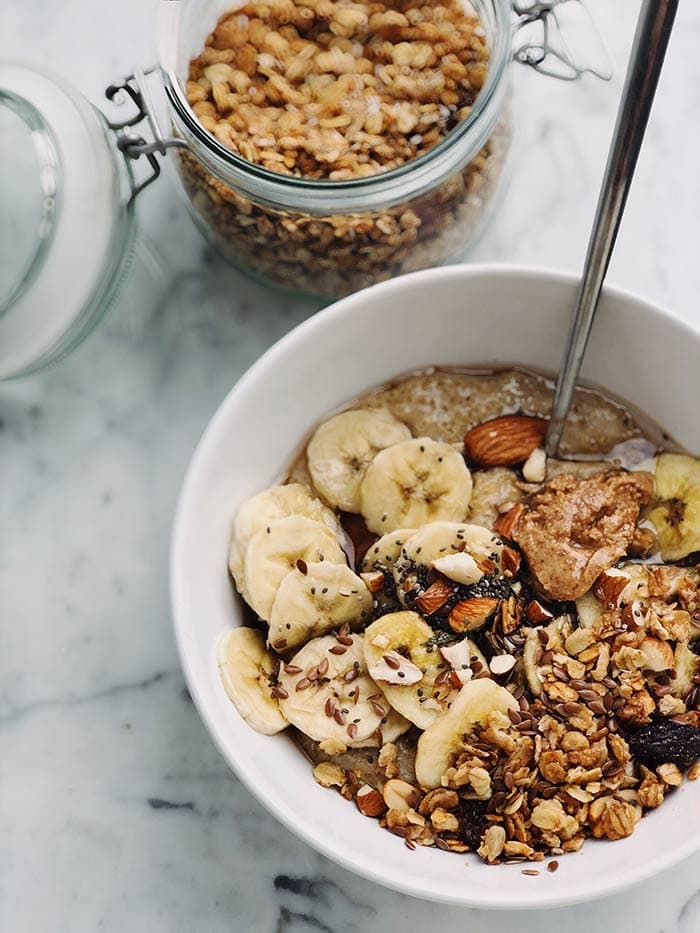
200 grams of brown rice, quinoa, soba noodles, brown rice noodles or potatoes
You can turn your dinner or lunch into a fiber rich meal by making sure that the base of your meal is a source of fiber:
- 200 grams of boiled brown rice – 4,3 grams of fiber
- 200 grams of boiled quinoa – 5,6 grams of fiber
- 200 grams of boiled soba noodles – 2,5 grams of fiber
- 200 grams of boiled potato, leave the skin on for extra fiber! – 3,6 grams of fiber
Karlijn: when I talked to Manon and started to pay more attention to the amount of fiber in certain foods, I noticed that I often automatically choose white rice or gluten-free pasta made from corn, which doesn’t contain any fibers.
Now I try to pick wholegrain options, such as gluten-free pasta made from buckwheat (which contains 4.5 grams of fiber per 100 gram). It really is all about making smart choices.
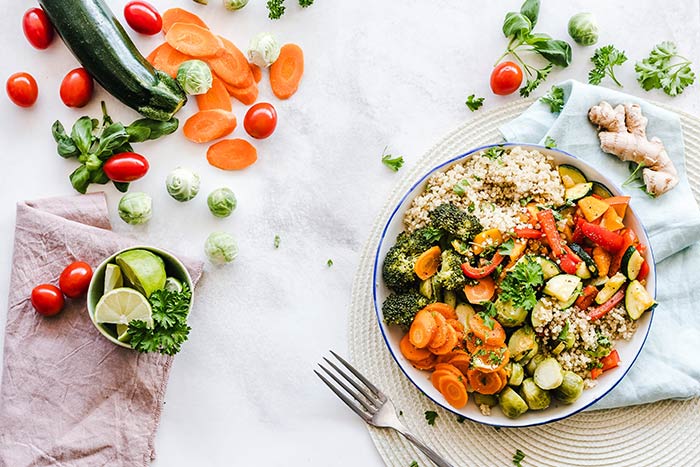
2 slices (70g) of whole grain sourdough bread
Sourdough bread is lower in FODMAPs than regular bread, because the sourdough breaks down FODMAPs. Two slices of wheat sourdough and spelt sourdough bread are a low FODMAP option. So find a sourdough baker near you or start making sourdough bread yourself.
If you look for sourdough bread in the supermarket, make sure that no yeast has been used. Usually the use of yeast is the sign of a “bad” sourdough bread. It is best when it is traditionally made! 70 grams of sourdough bread contains 4,2 grams of fiber.
Karlijn: I often buy my sourdough bread at a bakery or at the biological supermarket. Or I make it myself with my recipe for making sourdough spelt bread.
50 grams of nuts and seeds
Nuts and seeds are a little bit more difficult on the FODMAP diet because many kinds are only limited low FODMAP. But if you divide your servings over multiple meals, it is easier to reach your daily amount of nuts! You can divide it in three portions for example.
The following portion sizes are low FODMAP (check the Monash app for more options):
- 40 grams of Brazil nuts – 3 grams of fiber
- 15 grams of ground flaxseed – 5,2 grams of fiber
- 15 grams of hazelnuts – 1,4 grams of fiber
- 40 grams of macadamia nuts – 3,2 grams of fiber
- 28 grams of peanuts – 1,9 grams of fiber
- 23 grams of pumpkin seeds – 2 grams of fiber
- 30 grams of walnuts – 1,4 grams of fiber
Karlijn: I start the day with adding a serving of nuts and seeds to my breakfast: 15 g pecan nuts + 1 tbsp flaxseed. I also often sprinkle some mixed seeds over my salad.
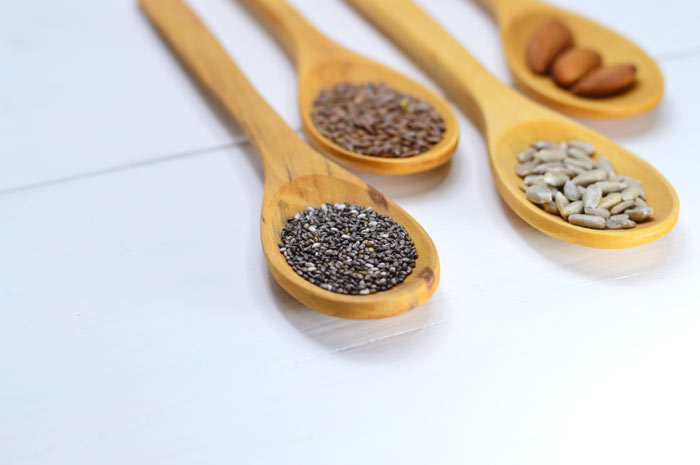
A small serving of low FODMAP beans
Beans are a great source of protein and fiber, but beans also have limited low FODMAP portion sizes. Try to make yourself a small salad every day, for lunch or as an afternoon snack, that contains vegetables and beans.
Examples of beans you can use:
- 38 grams of adzuki beans – 2,5 grams of fiber
- 40 grams of black beans – 3,2 grams of fiber
- 35 grams of butter beans – 1,8 grams of fiber
- 42 grams of chickpeas – 3 grams of fiber
- 90 grams of edamame – 6,1 grams of fiber
- 53 grams of mungbeans – 4 grams of fiber
A variety of these foods everyday will help you reach your fiber goals!
Depending on the products you choose, you will get over 30 grams of fiber on some days and a little under the 30 grams of fiber on other days. That doesn’t matter so much, as long as you try to get to 30 grams per day on average.
Slowly increase the amount of fiber you eat
Are you not eating a lot of fiber yet? Then slowly start to increase the amount of fiber in your diet. If you suddenly add a lot of extra fiber to your diet, that will cause complaints, especially when you have a sensitive gut. Therefore it is important to increase the amount of fiber slowly.
Start for example with adding extra fiber to your breakfast. If that goes well, add some extra fiber to your lunch 3 to 4 days after that. 3 to 4 days later your dinner and finally your snacks.
In the beginning you might notice that you feel a little more bloated, but that is a normal reaction to eating more fiber.
Karlijn: I am doing this in the same way. Manon checked my diet and noticed that I am not eating enough fiber yet. So I started with changing my breakfast. First I always ate polenta porridge and I have now changed that to teff porridge with red fruit.
To this, I add some nuts and flaxseed. After a few days, I started changing my lunch and now I am switching up my snacks for some more fiber rich options. Like this, my gut can get used to the higher amount of fiber slowly.
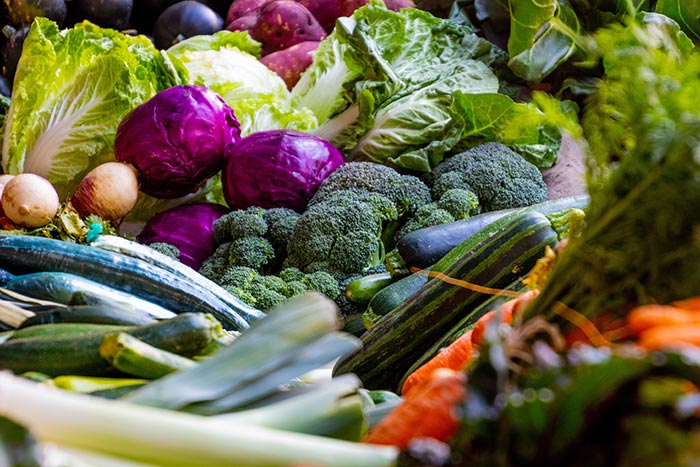
Do you have any good tips yourself on how to get enough fiber on the FODMAP diet? Please let me know in a comment!
Karlijn: I hope that you liked this blog written by Manon! Let me know if you like informative blogs like this one and if you would like to see more of these kind of articles on Karlijn’s Kitchen. Make sure to also take a look at Manon’s own blog, Positive Gut, where she shares more interesting articles.
(*) Sources:
- https://onlinelibrary.wiley.com/doi/epdf/10.1111/jgh.13688
- https://gut.bmj.com/content/gutjnl/64/1/93.full.pdf
Together we go for a calm belly!
Subscribe to the Karlijn's Kitchen e-mail newsletter for more tips and recipes and receive the ebook 10 things I wish I had known when I started the FODMAP diet for free!

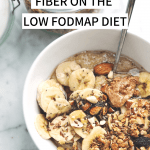
10 Comments
What a helpful article. Thank you so much. I would read more like this thank you.
You’re welcome!
This was a really helpful article. You talk about adding fibre through snacks. How much time must be left between meals and snacks to ensure you are not FODMAP stacking?
Note that FODMAP stacking occurs if you eat several foods from the same FODMAP group that are limited low FODMAP in a short period (you can read more about stacking here: https://www.karlijnskitchen.com/en/fodmap-stacking/). So spacing meals and snacks out is only necessary if you eat things from the same group that can add up in meals that follow each other up.
Monash advises to keep 3-4 hours between meals if you want to be totally sure. But if you pick foods as a snack that don’t contain any or very little FODMAPs, you can snack on those without being afraid of stacking. You can read more about that in this blog: https://www.monashfodmap.com/blog/how-avoid-fodmap-stacking/
Wonderfully informative blog with loads of really useful suggestions and ideas. Thank you!
Glad to hear that, you’re welcome!
Very helpful information. I know I need more fiber so this was great for getting me started.
Thank you so much for sharing this information. It’s very helpful and will aid in finding the right combinations!
Thank you Karlijn for all your suggestions and recipes.
You’re welcome 🙂